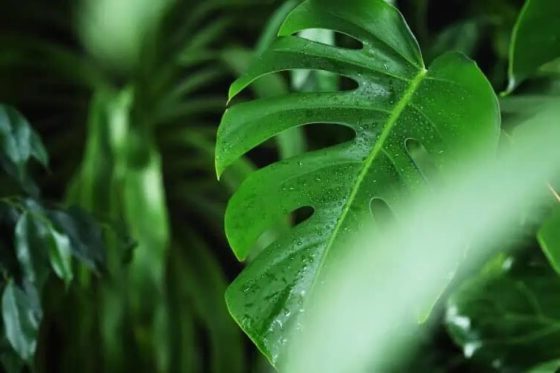Can monstera live outside? Yes, they can! If you’re a plant enthusiast seeking to add a touch of lushness to your outdoor space, look no further!
Monstera, with its iconic tropical foliage, can thrive outside with proper care and a suitable environment. Imagine the vibrant green leaves basking in natural sunlight while gently swaying in the breeze.
In this article, we’ll explore the factors to consider when transitioning your monstera outdoors and provide helpful tips to ensure its health and growth. So, let’s dive in and unleash the full potential of your monstera in an outdoor setting.
Can Monstera Live Outside? Experts Weigh In
Monstera plants, with their beautiful leaves and unique appearance, have become a popular choice for indoor gardening enthusiasts. However, many plant lovers wonder if these tropical plants can thrive outdoors.
In this article, we will delve into the topic of whether Monstera plants can live outside and explore the ideal conditions for growing these stunning plants.
Read More: About Understanding the Difference Between Stems and Stalks in Plants
Understanding the Nature of Monstera Plants
Before we determine whether Monstera plants can live outside, it’s crucial to understand their natural habitat and environmental requirements. Monstera plants belong to the evergreen plant family Araceae and are native to the tropical rainforests of Central America.
In the wild, they typically grow as epiphytes, climbing up trees and utilizing their aerial roots for support.
These plants thrive in warm, humid environments with temperatures ranging between 65°F to 85°F (18°C to 29°C). They are accustomed to indirect, filtered sunlight, as dense tree canopies in their natural habitat provide protection from direct sunlight.
Monstera plants also require well-draining soil and regular watering to keep their soil consistently moist but not waterlogged.
Factors to Consider Before Moving Monstera Plants Outside
While Monstera plants can potentially live outside, several factors need to be considered before making the decision to move them outdoors. Here are some important factors to take into account:
Climate
The climate plays a vital role in determining whether Monstera plants can survive outside. As mentioned earlier, Monstera plants thrive in warm, tropical environments. Therefore, if you live in a region with mild, frost-free winters and warm summers, you may be able to successfully grow Monstera plants outdoors.
It’s important to consider the hardiness zone of your area and check if it aligns with the temperature range preferred by Monstera plants. In general, Monstera plants can tolerate temperatures as low as 60°F (15°C) but may suffer damage or even die if exposed to frost or freezing temperatures for an extended period.
Lighting
Another crucial factor to consider is the lighting conditions in your outdoor space. While Monstera plants thrive in bright, indirect light, they are sensitive to intense, direct sunlight.
If your outdoor area receives direct sunlight for a significant part of the day, it’s advisable to provide some shade or choose a spot with filtered sunlight to protect the plant from sunburn and leaf damage.
If you have a shaded area with dappled sunlight or a spot with partial shade, it can be an ideal location for your Monstera plant to thrive.
Adequate lighting is essential for maintaining the vibrant green color of the leaves and promoting healthy growth.
Protection from Extreme Weather
Monstera plants are susceptible to damage from strong winds, heavy rain, and extreme weather conditions.
Before placing your Monstera plant outside, ensure that it is sheltered from harsh elements. Consider providing a protective barrier, such as a fence, wall, or a strategically placed trellis, to shield the plant from strong winds.
In areas prone to heavy rainfall, ensure proper drainage to prevent waterlogging, which can lead to root rot. You may also need to bring the plant indoors during severe storms or adverse weather conditions to protect it from potential damage.
Transplanting Monstera Plants Outdoors
If you have considered the factors mentioned above and believe that your outdoor conditions are suitable for Monstera plants, you can proceed with transplanting them outdoors. Here’s a step-by-step guide on how to successfully transition your Monstera plant from indoors to outdoors:
Choose the Right Time
The ideal time to transplant your Monstera plant outdoors is during the spring or early summer when the risk of frost has passed, and the temperatures are consistently above 60°F (15°C). Transplanting during this time allows the plant to acclimatize gradually to the outdoor conditions and promotes better root establishment.
Select the Ideal Location
Identify a suitable location in your outdoor space that meets the lighting requirements of your Monstera plant. Aim for a spot with bright, indirect sunlight or partial shade. Consider any natural shade sources, such as trees or buildings, that can provide protection from intense sunlight.
Prepare the Soil
Ensure the soil in your chosen outdoor planting area is well-draining and rich in organic matter. Monstera plants prefer soil that retains moisture but does not become waterlogged. You can amend the soil with compost or well-rotted manure to improve its fertility and drainage capacity.
Acclimate the Plant
Before moving your Monstera plant outdoors permanently, it’s important to acclimate it gradually to the new environment. Start by placing the plant in a shaded outdoor area for a few hours each day, gradually increasing the duration over a week or two. This process helps the plant adjust to the outdoor lighting and temperature variations.
Planting and Care
Dig a hole slightly larger than the root ball of your Monstera plant and gently place it in the hole. Backfill with soil, ensuring that the plant is at the same depth it was in its original container. Firmly pat the soil around the plant to eliminate any air pockets.
Water the plant thoroughly after transplanting and continue to keep the soil consistently moist but not waterlogged. Monitor the plant for signs of stress, such as wilting or yellowing leaves, and make adjustments to watering or lighting conditions if necessary.
Monitoring and Maintenance
Once you have successfully transplanted your Monstera plant outdoors, regular monitoring and maintenance are essential to ensure its continued growth and well-being. Here are some key points to consider:
- Regularly check the moisture level of the soil and adjust watering accordingly. Avoid overwatering, as it can lead to root rot, but don’t let the soil dry out completely.
- Inspect the plant for signs of pests, such as aphids or spider mites. Treat any infestations promptly using suitable organic or chemical methods.
- Prune your Monstera plant as needed to remove dead or yellowing leaves, promote new growth, and maintain its desired shape.
- Provide additional support, such as a trellis or stake, if your Monstera plant starts to climb or requires extra stability.
- During periods of extreme weather or frost, consider providing temporary protection to your Monstera plant, such as covering it with a frost cloth or moving it indoors temporarily.
While Monstera plants are primarily known for thriving indoors, they can be successfully cultivated outdoors under the right conditions. By considering factors such as climate, lighting, and protection from extreme weather, you can create an ideal environment for your Monstera plant to live outside.
Remember to follow proper transplanting procedures and provide ongoing care to ensure the continued health and growth of your Monstera plant in its new outdoor home.
Read More: About Does Monstera Like Coffee Grounds?
Frequently Asked Questions (FAQs)
Yes, Monstera plants can live outside in certain conditions. However, they are primarily tropical plants and thrive best in indoor environments.
Monstera plants prefer warm and humid climates. They can tolerate temperatures between 60-85°F (15-29°C) and humidity levels above 60%. They also require bright, indirect sunlight.
Monstera plants are not suitable for cold climates as they are sensitive to temperatures below 50°F (10°C). If you live in a colder region, it’s best to keep your Monstera indoors or provide it with proper protection during colder months.
Yes, Monstera plants can be grown in a garden if the climate and conditions mimic their preferred indoor environment. It’s important to ensure the soil is well-draining and the plant receives adequate shade from direct sunlight.
Keeping Monstera outdoors exposes them to various risks such as extreme temperatures, sudden weather changes, strong winds, pests, and diseases. These factors can negatively impact the health and growth of the plant.
While it is possible to plant Monstera directly in the ground, it is recommended to use a large pot or container. This allows for better control over the plant’s environment and makes it easier to move indoors during unfavorable conditions.
If you plan to transition your Monstera from indoors to outdoors, it is important to acclimate the plant gradually. Start by placing it in a sheltered outdoor area with partial shade and gradually increase the exposure over a few weeks.
The watering frequency for outdoor Monstera plants depends on various factors such as temperature, humidity, and soil type. Generally, it is recommended to water thoroughly when the top inch of soil is dry. Avoid overwatering as it can cause root rot.
Final Thoughts
Monstera, also known as the Swiss cheese plant, is a popular indoor houseplant. While it thrives in indoor environments, many plant enthusiasts wonder if it can also live outside. The answer is yes, monstera can survive and even thrive outdoors, given the right conditions. However, it is important to consider factors like climate, sunlight, and protection from extreme weather.
With adequate care and attention, such as providing shade during hot summer days and protecting it from frost in winter, you can enjoy the beauty of monstera in your outdoor space. So, can monstera live outside? Yes, it can, with proper care and consideration.
Auto Amazon Links: No products found.
Perfect Plants Christmas Tree Saver 8oz. | Easy Use Xmas Tree Preserver Food | Have Healthy Green Christmas Trees All Holiday Season
$9.97 (as of December 5, 2025 00:43 GMT +00:00 - More info- Product prices and availability are accurate as of the date/time indicated and are subject to change. Any price and availability information displayed on [relevant Amazon Site(s), as applicable] at the time of purchase will apply to the purchase of this product.
Kaiedos Christmas Tree Watering Funnel - 39 Inch Funnel, Reusable Design, Makes Watering Your Live Tree a Snap!
$14.99 (as of December 5, 2025 00:43 GMT +00:00 - More info- Product prices and availability are accurate as of the date/time indicated and are subject to change. Any price and availability information displayed on [relevant Amazon Site(s), as applicable] at the time of purchase will apply to the purchase of this product.
Wilt-Pruf® Christmas Tree/Cutting Preserver Spray |Preserves Christmas Trees, Wreaths, Garlands, Cuttings and Carved Pumpkins | Reduces Needle Drop | Keeps Cut Trees Fresh Longer | Natural (32 oz)
$21.99 (as of December 5, 2025 00:43 GMT +00:00 - More info- Product prices and availability are accurate as of the date/time indicated and are subject to change. Any price and availability information displayed on [relevant Amazon Site(s), as applicable] at the time of purchase will apply to the purchase of this product.
Forest Fresh Christmas Tree Preservative Tablets – Tree Water Additive for Live Fresh-Cut Trees – Keeps Trees Hydrated and Reduces Needle Drop – Non-Toxic, Made in USA – 1 Packet (8 Tablets)
$5.99 (as of December 5, 2025 00:43 GMT +00:00 - More info- Product prices and availability are accurate as of the date/time indicated and are subject to change. Any price and availability information displayed on [relevant Amazon Site(s), as applicable] at the time of purchase will apply to the purchase of this product.
IPOOLTENG Christmas Tree Watering Funnel 3 Tube 1 Funnels 40 Inch - 3 Section Plastic Christmas Tree Funnel Waterer, Long Funnels for Watering Trees, Best Gifts for Your Parents to Water Tree
$14.53 (as of December 5, 2025 00:43 GMT +00:00 - More info- Product prices and availability are accurate as of the date/time indicated and are subject to change. Any price and availability information displayed on [relevant Amazon Site(s), as applicable] at the time of purchase will apply to the purchase of this product.
Cuisinart 6.5" Cast Iron Smashed Burger Press, Round Flat Edge Grill Press for Crispy Smash Burgers, Burger Tool for Grill and Griddle Accessories, for BBQs and Tailgates
$24.99 (as of December 4, 2025 16:51 GMT +00:00 - More info- Product prices and availability are accurate as of the date/time indicated and are subject to change. Any price and availability information displayed on [relevant Amazon Site(s), as applicable] at the time of purchase will apply to the purchase of this product.
Snow Joe Premium Enviro Blend Ice Melt, Green-Coated Deicer Crystals, 50 lb - Safer Melter for Vegetation, Concrete & Metals w/ Anti-Corrosion Calcium Magnesium Acetate
$32.97 (as of December 4, 2025 16:51 GMT +00:00 - More info- Product prices and availability are accurate as of the date/time indicated and are subject to change. Any price and availability information displayed on [relevant Amazon Site(s), as applicable] at the time of purchase will apply to the purchase of this product.
Muddy Mat® Shown on TV Super Absorbent Microfiber Dog Door Mat for Muddy Paws, Non-Slip Washable Pet Rug, Quick Dry Chenille Entryway Carpet, Machine Washable Indoor Outdoor mat, Grey 30"x19"
$19.95 (as of December 4, 2025 16:51 GMT +00:00 - More info- Product prices and availability are accurate as of the date/time indicated and are subject to change. Any price and availability information displayed on [relevant Amazon Site(s), as applicable] at the time of purchase will apply to the purchase of this product.
OLANLY Dog Door Mat for Muddy Paws 30x20, Absorbs Moisture and Dirt, Absorbent Non-Slip Washable Doormat, Quick Dry Chenille Mud Mat for Dogs, Entry Indoor Entryway Carpet for Inside Floor, Grey
$9.99 (as of December 4, 2025 16:51 GMT +00:00 - More info- Product prices and availability are accurate as of the date/time indicated and are subject to change. Any price and availability information displayed on [relevant Amazon Site(s), as applicable] at the time of purchase will apply to the purchase of this product.
Zevo Flying Insect Trap Official Refill Cartridges - Fits Both Zevo Trap & MAX Indoor Fly Trap - Authentic Trap+Lock Technology to Catch Gnats, House & Fruit Flys (4 Official Refill Cartridges)
$14.97 (as of December 4, 2025 16:51 GMT +00:00 - More info- Product prices and availability are accurate as of the date/time indicated and are subject to change. Any price and availability information displayed on [relevant Amazon Site(s), as applicable] at the time of purchase will apply to the purchase of this product.











